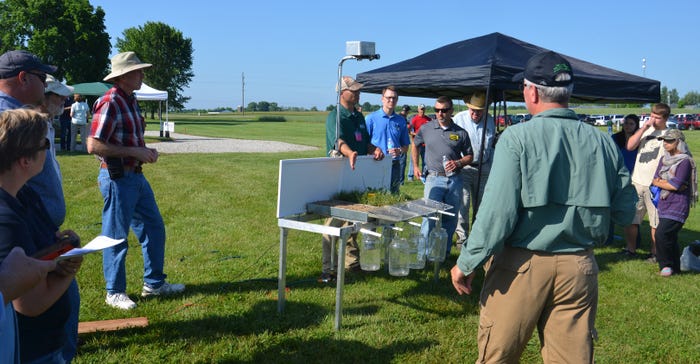
You’ve probably seen a simple rain simulator in action before. Soil conservation researchers use them to measure the amount of soil which runs off during a rain event, but many groups also set them up at conservation field days and farm shows to demonstrate the power of raindrops and the impact of soil erosion.
Typical rain simulators have three trays. One is filled with dirt with no cover, representing conventional tillage. The second may be filled with grass sod, representing a field in permanent pasture. The third may either be cornstalk residue or a growing cover crop. A water source simulates a rain and may be calculated to deliver a certain amount of “rain” in a short time, simulating a thunderstorm. Water and sediment, if it runs off the “field” represented by trays, collects in glass jars below the trays.
Ben Lambeck, district conservationist with the USDA Natural Resources Conservation Service office based in Benton County, Ind., brought a modified rain simulator to the Big Pine Watershed field day on Rick Clark’s farm near Attica, Ind., recently. It had the familiar three trays of soil, sod and cover crops for comparison purposes, but it had two jars to collect water leaving each “field” instead of one. One jar collected runoff, as in most simulator demonstrations. But the other jar was positioned underneath the field. Holes in the bottom of the trays allowed water that penetrated the soil to drip into those jars.
Infiltration power
What this simulator demonstrated was the difference in infiltration ability of the various types of fields represented, not just what would happen on the surface, Lambeck noted. One big advantage of cover, especially living cover, is that it usually allows more water to run into the soil and percolate through the profile. Then, it’s available when needed later in the season.
Barry Fisher, USDA NRCS soil health specialist, helped explain what happened after the simulator delivered the equivalent of a half-inch of rain in just a few minutes. “The jar catching runoff from the bare field contained dirty water,” Fisher said. “That’s not a surprise. Soil particles are dislodged by raindrops and move off the field.
“The jar collecting runoff from the sod field had little water in it, and it was clear,” Fisher said. “There was some runoff in the field with cover crops and annual plants, and there was some sediment in it, too. The living cover helps, but it’s not as effective as a 50-year-old sod.”
The surprise came in the jars under the trays — the ones you usually don’t see in these demonstrations, Fisher said. “There was virtually no water in the jar under the bare-field tray. Water ran off instead of infiltrating into the soil. In fact, if we had only done the demonstration once and then turned the bare-field tray upside down, dust would have poured out from the bottom. Water doesn’t move into and through conventionally tilled soil very quickly.
“The jar under the sod field had a considerable amount of water, and it was fairly clear. That represents how water moves into a grass cover and down into the profile,” Fisher said. “The jar under the cover crop tray had water in it, indicating that it was allowing some infiltration.”
About the Author(s)
You May Also Like




